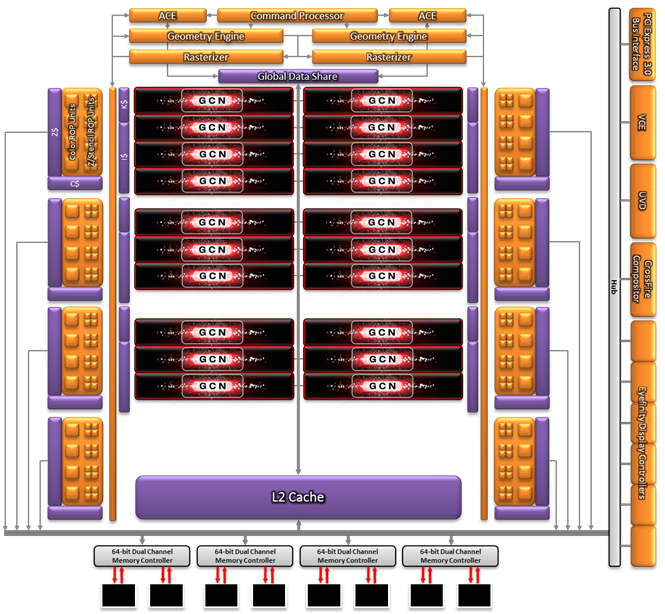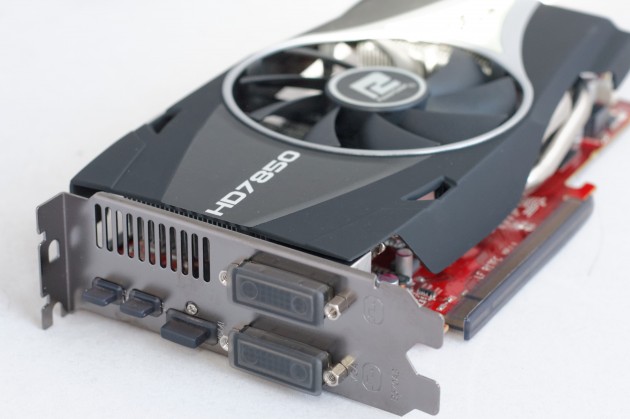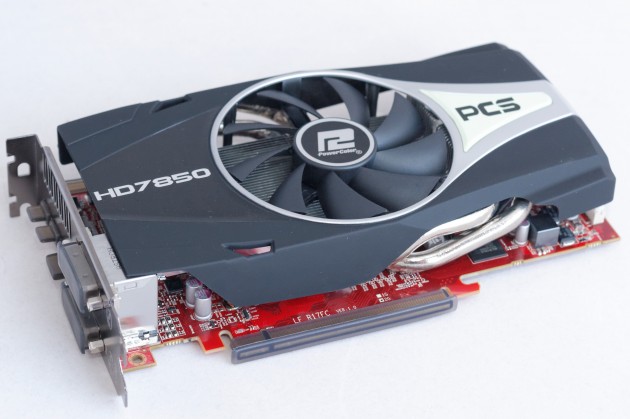In the crazy world of enthusiast graphics cards, PowerColor is not a brand that often rises to the front of people’s minds. Gamers and PC enthusiasts tend to be rather loyal to the brands that have treated them well, and are slow to notice (and quick to discount) smaller names without even really thinking about it. So it goes with PowerColor, which, if you read a lot of tech forums or PC gaming sites, remains relatively unnoticed in a world of ASUSes and SAPPHIREs. It’s not due to a lack of quality, however. Rather, it could be said that their marketing machine needs some work. To that end, they’ve made some new marketing and PR staff changes that may just help vault them to the forefront of Radeon buyers’ minds—if the hardware stacks up. That’s what we’ll find out today with the PowerColor PCS+ Radeon HD7850 2gb GPU.
A little bit about PowerColor
PowerColor is one of several GPU brands owned by the “TUL Corporation” out of New Taipei, Taiwan. TUL itself branded graphics cards as recently as 2011, but appears to have taken the background to its subsidiary brands: PowerColor, VTX3D and Club3D, with the latter two being almost entirely unheard of to our North American readership. Together, these brands represent a not insignificant chunk of AMD’s total graphics card volume, and an even more impressive assortment of oft-overlooked engineering accomplishments.
A quick look at architectures
The PowerColor PCS+ HD7850 is based on the graphics chip AMD has codenamed “Pitcairn Pro.” Pitcairn Pro fills the $199-$229 price band in AMD’s “Southern Islands” family of products, which is better known to the public as the AMD Radeon HD 7000 Series. All such chips are based on the Graphics Core Next architecture.

A high-level block diagram of the “Pitcairn” design, based on AMD’s Graphics Core Next archtiecture.
AMD alleges a couple key advantages for the GCN Architecture:
- A 256-bit memory bus on the HD 7850, which substantially inhibits the performance falloff observed on the competing GeForce GTX 650 Ti when games with big textures or higher AA settings can starve a GPU of memory bandwidth.
- Notably higher real-world compute performance than the competing “Kepler” architecture from NVIDIA, which is a tremendous advantage for GPU compute-powered effects in games, including virtually every major lighting, shadowing and post-processing effect in a DirectX 11 game.
- A new anisotropic filtering algorithm, which produces sharper and less shimmery textures than competing methods. The new filter is automatically enabled when users enable AF in their favorite games.
- AMD PowerTune technology, a performance feature best explained in detail by Icrontic’s resident AMD Product Marketing Manager, Robert “Thrax” Hallock.
- AMD ZeroCore Power technology, which automatically shuts down the GPU when the connected monitor goes into suspend. The same technology will also shut down secondary GPUs in a multi-GPU config when the user goes back to the desktop.
- AMD HD Media Accelerator, which is a dedicated block of silicon capable of decoding any major codec (VC-1, H.264, MPEG-4 ASP, WMV-HD, MPEG-2) up to the maximum bitrates defined in their specs.
The PCS+ HD7850 summarized
The most essential thing you need to know about this card is that it’s the fastest HD 7850 on the market. Period. Rather than the bog-standard 860MHz clockspeed defined by AMD for the HD 7850, PowerColor cranked this bad boy up to 1000MHz out of the box, and specified overclocking headroom to spare.

The PowerColor PCS+ HD7850, with stacked DVI, HDMI and a pair of mDP ports on that classically ATI cherry red PCB.
Secondly, the PCS+ HD7850 has the fastest VRAM of any HD 7850 on the market at 1225MHz. That’s a mere 25MHz higher than everybody else, which admittedly means very little for overall framerates, but it still speaks to the kind of attention PowerColor has paid to their PCS+ board.
Finally, you should know that the PCS+ HD7850 is a seriously quiet graphics card. The overhanging heatpipes might seem a touch overdone, but the dissipation potential of PowerColor’s thermal solution makes it a shockingly quiet contender. While I don’t have the equipment to do a proper acoustics evaluation, I can say that it’s significantly quieter than the reference 7850 from AMD, and certainly doesn’t add any noise at all to my system’s sound profile, even under load.

Size is everything… for a heatpipe. A big-ass heatsink pushes the PCS+ HD7850 to appreciably quiet volumes, even at load.
On the whole, PowerColor’s optimizations to the official Pitcairn Pro design places the PCS+ HD7850 in the same performance class as the bigger HD 7870… for nearly $50 less. A price discussion of AMD Radeon cards can’t really be had right now without mentioning the ubiquitous “Never Settle” free copy of BioShock Infinite and Tomb Raider if you buy from a participating retailer, which is almost everyone. The value of current AAA gaming titles tacked on, for free, to any of these cards is a serious competitive advantage, without a doubt.
Specifications
| Process | 28nm | |
| Architecture | Graphics Core Next | |
| Stream Processors | 1024 | |
| Engine Clock | 1000MHz | |
| Memory Clock | 1225MHz | |
| Memory Bus Width | 256-bit | |
| Memory Bandwidth | 156.8GB/s | |
| Typical Board Power | ~130W | NOTE: Single 6-pin power connector |
| Idle Power | <15W | NOTE: Typical desktop use (e.g. browsing) |
| Long Idle Power | <3W | NOTE: AMD ZeroCore Power mode |
| Display Outputs | 1x DL-DVI 1x SL-DVI 1x HDMI 2x mDP 1.2 |
NOTE: DL-DVI or DP required for 2560×1440+ resolutions |
Performance
The benchmark system is an AMD FX 8350+ with 24gb of AMD DDR3, running Windows 8 64 with the latest WHQL Catalyst drivers and an OCZ SSD.
3DMark (the very latest version) was used for testing
Stock PowerColor PCS+ HD7850:
2258 Fire Strike
16256 Cloud Gate
101142 Ice Storm
Stock Radeon HD7870 for comparison:
4872 Fire Strike
16471 Cloud Gate
101602 Ice Storm
Getting more than you bargained for
Ah, but wait—there’s more to the story. Using their PowerUp Tuner software (which, inexplicably, is not mentioned or included anywhere in the package, but if you go to the PowerColor website, you can find it), I was able to crank this baby up to 1200mhz. The story changes significantly at that point.
Overclocked PowerColor PCS+ HD7850 (1200mhz)
4868 Fire Strike
16468 Cloud Gate
101590 Ice Storm
If you get it into the 1200MHz range, it’s, for all practical purposes, as fast as a Radeon 7870, and extremely close to the performance of the 7950. It costs about $125 less than that card, so we’re talking some serious benefit to OCing, and that’s clearly what this card is designed for.
Ergo, therefore, in conclusion, etc…
 For those who have purchased a Radeon GPU in the last few years, there’s a pretty good chance you’ve gone with one of the big names: ASUS, SAPPHIRE, or the like. While the PowerColor name may be passingly familiar to you, there’s probably a decent chance that the lower prices of their products seemed suspicious. I’m here to tell you, your suspicions were unwarranted. This unassuming little board is proof that not every GPU is the same, and that engineering prowess can not always be measured by the number after the dollar sign. Overclocking this baby is where it’s at.
For those who have purchased a Radeon GPU in the last few years, there’s a pretty good chance you’ve gone with one of the big names: ASUS, SAPPHIRE, or the like. While the PowerColor name may be passingly familiar to you, there’s probably a decent chance that the lower prices of their products seemed suspicious. I’m here to tell you, your suspicions were unwarranted. This unassuming little board is proof that not every GPU is the same, and that engineering prowess can not always be measured by the number after the dollar sign. Overclocking this baby is where it’s at.
The TL:DR is this: the PowerColor PCS+ HD7850 is a league of its own amongst other HD 7850s, it’s every bit as fast as an HD 7870, it’s $50 cheaper than the 7870 at your favorite retailer, and it comes with $120 in free games. For this reason alone, I am absolutely comfortable with awarding this GPU our Silver Outstanding Product award for really pushing the bar and being best-in-class.










 Articles RSS
Articles RSS